Low-Ready Slicing in CQB
Nathan Wagar
CQB training is a funny world, and I often find myself in arguments that shouldn’t exist, because they are so demonstrably wrong in actual training that it should be self-evident. Sadly, this is not the reality we live in. Tactical Dogma becomes institutionalized because we learn it from institutions of violence such as the military. This is not a bad thing, it is necessary in one sense to pass on information to society as whole. But when the dogma becomes disconnected from dialogue outside of the institution, it becomes a problem.
One such seemingly small issue is where to hold the weapon while slicing on a doorway or corner. The two main camps are those that:
- Keep the weapon at eye level, usually looking through their optic (sometimes just over).
- Keep the weapon at low ready, confirming the sector of fire, then quickly raising it after PID.
Most people are familiar with the first technique; it was the way I had initially learned as a private in basic training. The second method is the one I currently use now, and it can be seen in these videos below.
The Debate
Those in the first school of thought have concerns that the second method leads to necessarily slower reaction time between identifying the threat and putting rounds on target, since raising the weapon causes a time lapse that could get you killed. This is false, and I will explain why very simply, before going in more depth.
Let’s put the problem like this:
- I have to PID the threat.
- I have to shoot him.
- I have to do it in that order.
- I can’t see through something in front of my face.
If you think it through, that tells you all you need to know right there. But because the purpose of the Borderland approach is applying complex systems science (CSS) to training with a high level of analysis, we are going to not just refute a poor technique but crush it, salt the earth, and hear the lamentations of its women. With that in mind, let’s dive into this with systems concepts.
Sensitivity to Initial Conditions
In complex systems, the edge between two different states, structurally or in time, is the most chaotic part of the system. It is the dividing line before another system state, and any small deviation spreads like ripples in a pond. This means that your small fuckups will turn into exponentially bigger ones in a compressed time frame as you move into the new state; you are basically setting yourself up for failure.
In CQB, any time we get to an “edge,” whether a doorway or simply a corner, that “edge” serves as the system edge between two states: the room you are in, and the room you are entering. The doorway is where the CQB magic happens. If properly controlled, the system edge allows you to dominate the new system state (room) with very small adjustments. In the case of slicing the doorway, a small motion of the muzzle can clear a large section of the room.
Conversely, if you mess up at the edge, you can lose it all, and end up in deep shit upon entry. The key takeaway here is that the closer you get to that dividing system boundary, the more the small details matter. Get them wrong, and your CQB scenario can go catastrophic in no-time flat.
Concepts
Complex systems are interrelated, sometimes even chaotic, objects and processes that take place in time. Human beings have the ability to master a set of skills, then treat that set as its own system that serves as a single component of a new, higher level system. This makes a complex system hierarchical. An example would be in boxing, where each component is a different punch, with the system being a 3 point combination. Once the boxer has that down, that combination becomes its own system component of other, higher level tasks.
There are limits, though. As stated earlier, complex systems take place in time, and so time serves as a constraint on what we can do. In order to develop speed, a boxer needs to start combining some of the elements of a 3 point combination to execute simultaneously. When learning a shovel hook to the liver, a beginner is taught to step forward at an angle, lower his level, throw his punch to the body, return to his crouch, move back out of range, then stand up. This is good sequence for a drill, and linear teaching has its uses for skill acquisition.
But in the swirling reality of time, nobody throws a body shot that way. So the boxer doubles up on certain tasks. He may step forward at the same time he is changing levels, or after throwing the punch he may step out of range as he is returning to his crouch.
Although he can combine systems for maximum efficiency, he obviously can’t do everything at once, even structurally. He can’t throw a hook before he steps forward, and he can’t change levels back standing before he steps out of range. So we have certain processes that can be combined, and we have certain processes that have to happen sequentially.
I use the boxing example on purpose, to take us completely out of the CQB mindset and our own passionate beliefs about it. Now let’s return to the slicing issue. First, let’s look at the component systems that have to take place.
I am a system, and I have a few system variables that I can control: Eye direction, finger on or off the trigger, cognitive focus, and muzzle orientation. Once I visually locate an unknown, I enter into a larger system of threat control. I have three core system processes/dynamics that need to take place in order: I need to PID the threat, I need to achieve a sight picture, and I need to engage the target.
Each of these processes have to be in a specific “state” for the processes to be successful, and so some of these states also need to be in order. Think of a state as a snapshot of a system at any given moment in time. For our needs, core states also serve as a reference point.
Emergent (Main) System: Reacting to Contact
Core System Process 1: Threat PID
Core System State:
My eyes on the unknown’s hands
My finger off the trigger
My cognitive determination of threat
Core System Process 2: Attaining Sight Picture
Core System State:
My eyes on center mass
My muzzle on center mass
My cognitive determination of sight picture
Core System Process 3: Engaging Target
Core System State:
My eyes on center mass
My muzzle on center mass
My cognitive determination of sight picture
My finger on the trigger
Where our muzzle is oriented has some flexibility in transition between the core states, but not once the core states have been reached. The three core processes are a shift of the eyes, a movement of the trigger finger, and a cognitive shift in focus. The reason these are core processes is because each of them must shift from a 1st state to a 2nd state in order to progress with the overall system of reacting to contact.
I may be able to start with a non-core process like muzzle orientation at center mass, and maintain it there while I visually check the hands, then bring my eyes to my weapon to move to the next core process and engage the threat. What I cannot do, is start with my eyes on center mass, leave them there, and expect to ever move past step one of Threat PID.
This also means that it is not possible for me to move any faster than those core processes in execution order. No matter what happens, I cannot move faster than my eye switch, my cognitive switch, and my finger movement. Anything I do otherwise such as muzzle orientation, is irrelevant as long as I do it faster than the core processes.
If you are in the military you probably are already well aware of this concept in a different form: You can get to the motor pool as early as you want in the morning (process), you can even leave, get ice cream and come back (process), but you aren’t getting your trucks serviced until the mechanics feel like opening up the maintenance bay (core process).
For a more pertinent example, see some of the research by Force Science, where the difference between a 45 degree low ready and a tactical slightly lowered ready, all the way up to target acquisition and firing one round, was identical at .83 seconds. Even when the barrel actually has farther to travel, the core process of cognitive determination overrides that of sight picture and muzzle orientation, making those two irrelevant as long as they take place faster than the cognitive shift.1)Bill Lewinski, “Biomechanics of Lethal Force Encounters: Officer Movements,” in The Police Marksman 27, no. 6, November, 2002, 19-23.
So now we see that we can go only as fast as the core process states allow in execution order, but conversely we can manipulate our non-contingent systems any way we please without sacrificing speed as long as we move at least as fast as our eye/cognition/trigger-finger switch. This leaves the final remaining task of choosing the most effective method of muzzle orientation within those core parameters.
I can’t see through things that are in front of my face. But I have to have eyes on the hands. This gives me a few options.
- False Option: I can sight over my weapon system at center mass, and clearly see the hands, with nearly 0 transition from PID to engaging the threat.
- Bad Option: Sight over the top of my weapon system at the Unknown’s hands, determine threat, then move as a unit to the center mass for sight picture, and squeeze the trigger.
- Preferred Option: I can have my weapon lowered, PID, then move as a unit straight up to center mass.
Problems with False Option 1
The fact is, you can’t see through your weapon and locate the hands. This becomes more egregious an issue the closer the threat is. This means that even if you don’t believe it, you are in fact always moving your sight obstruction, whether it is your weapon or your own hands, however briefly, to acquire a visual of the Unknown’s hands. You are achieving this either by lowering your weapon on the vertical plane, sweeping it on the horizontal, or some combination of the two.
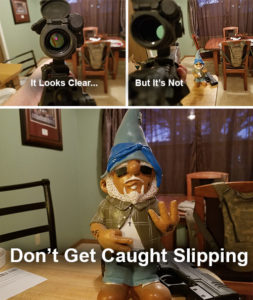
And in that case, guess what? You are off center mass, and have to get back on target anyway, except with an extra step. Why an extra step? Because first you had to cognitively grasp, not that the Unknown did or did not have a weapon, but rather that you couldn’t see his hands, you had to find his hands, then that he did or did not have a weapon. This eats up reaction time in between your core process-states.
Problems with Option 2
In boxing, we always harp on people not to look at the hands. Why? Because the more you actually orient yourself cognitively and structurally on the hands, the more fucked up you get. Not only is it harder to reorient yourself visually from the hands back to your target, during that visual switch from the opponent’s weapon to his vitals you can actually lose the target.
If I am looking at a guy’s hands, he punches me, I defend, them switch to find my target, he has already circled off. Then the shitty part is that as I also try to circle and visually reacquire him, he throws a counter and I run right into a fist. Now picture that process with bullets.
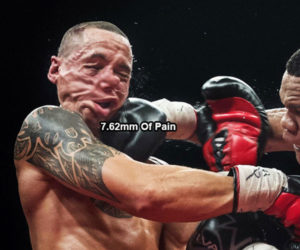
We visually process larger things before narrowing down to smaller things. This is because the way we identify anything visually is in light of the whole. I only know a human hand is in fact human, and therefore even a hand, because I visually see and cognitively determine his human shape, then I move to the particulars of the hand. Even if this doesn’t happen visually, it always happens cognitively. I only see a hand and recognize it as a human hand because I am familiar with the human as a whole.
Trying to use a narrowed field of view to find something small, then move back to the whole, just to zoom back in and find the small target of center mass, is just as inefficient and downright counteractive as the example from boxing.
What this inevitably leads to is a compromise, where the shooter actually uses his peripheral vision to acquire the human shape as he moves his weapon to the hands, then again moves his eyes off the weapon back to the body to swing his weapon into place. This is really just a sexed up version of the false option 1, using peripheral vision during muzzle sweep.
Whether I move my eyes off the weapon or the weapon away from my eyes, the result is exactly the same as raising a lowered weapon, except I added a cognitive boo boo in the process. Further, if I move my eyes off the weapon, nothing says that my weapon is where I left it. Have you ever noticed that when you look sideways while driving a car, the car tends to steer in the same direction you were looking? Then you have to get both your eyes and your vehicle back in between the lines. Your weapon is no different.
Preferred Option
This involves having the weapon lowered, finding the large shape immediately within your wide field of view, finding the hands immediately because of your wide field of view, snapping the weapon up and achieving a near simultaneous sight picture and trigger squeeze. You often may not need the sight picture at extremely close range because of the boreline-optic differential on the M-4 platform, and so can sight over the optic and cut down even further on your core process. No fuss, no chaos in the transitions, no extra steps. It’s precision in process, it will work the same way every time, and it works with behavioral realities.
You may have noticed that I haven’t even touched on the behavioral aspect of this; I have mainly tried to show that other methods are unsound even in theory, on a structural level. But it is easy to point out that your vision will constrict under stress as your pupils dilate, you will rely on peripheral vision anyway for larger shapes and movements, and so you will want to use a “soft focus” as often as possible even aside from the fact that your body will frequently make you.
Any technique that constricts your vision even more will lead to increased time and increased chaos in the system as you try to reorient yourself on your next core process; and this will especially impact your reaction time for the cognitive core process. Do it right the first time and keep your weapon lowered until you PID.
How did this argument even happen? Simple. Paper target training. Nobody puts a paper target right by the door of the shoot-house, and no paper target pushes your weapon up into a nearly impossible retention issue as you enter. Paper targets don’t move or wave their hands around as you try to run through the steps in real time, while simultaneously dealing with your own stress response.
Get off the paper targets, pack some hard hitting sims, and do some real training with non-compliant OPFOR. Then these armchair debates wouldn’t need to take place, and we could all focus on moving our knowledge of combat forward.
References
| ↑1 | Bill Lewinski, “Biomechanics of Lethal Force Encounters: Officer Movements,” in The Police Marksman 27, no. 6, November, 2002, 19-23. |
|---|


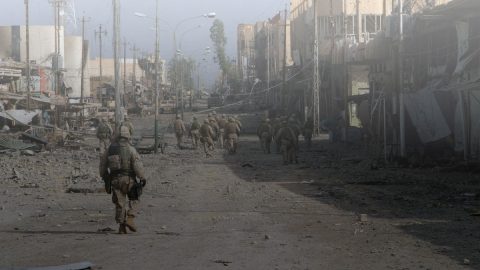
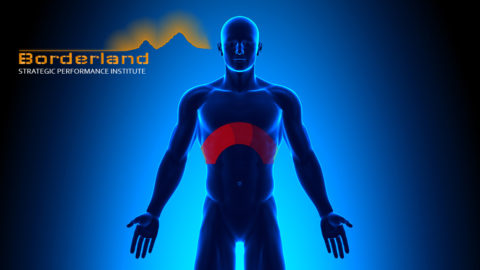
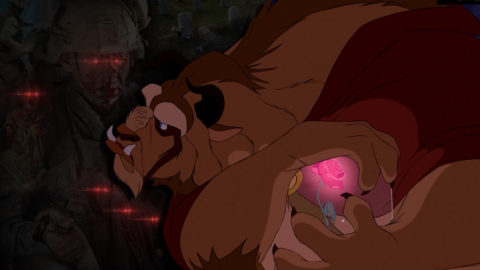
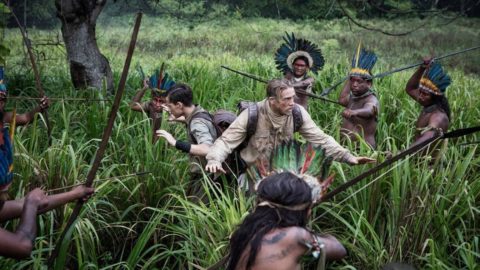
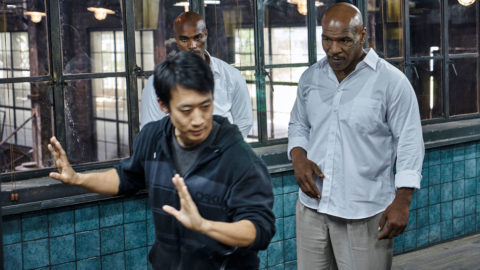
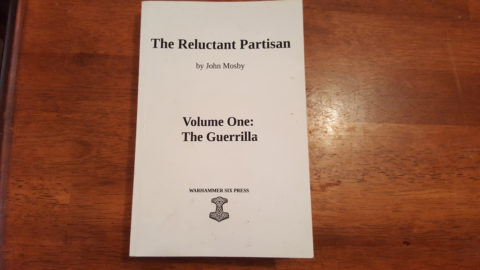
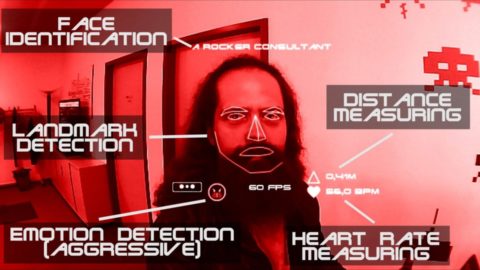
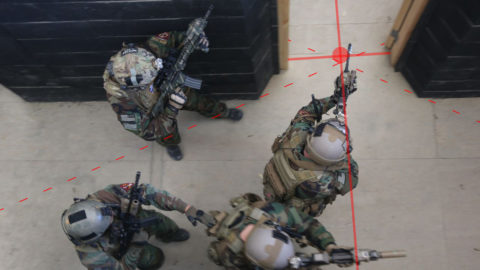
 Rob Brotzman
Rob Brotzman  Nathan Wagar
Nathan Wagar